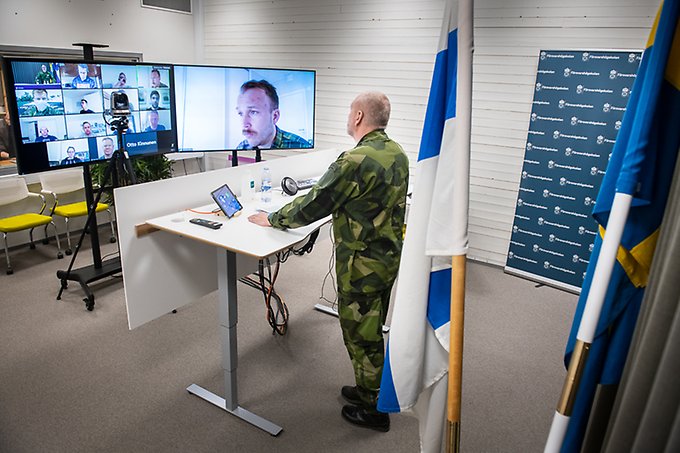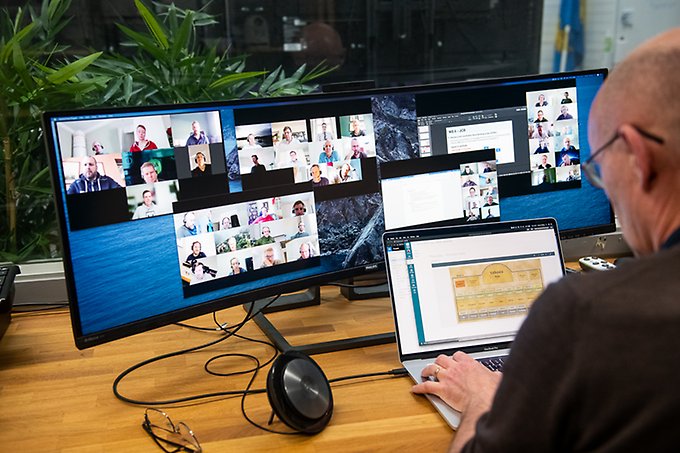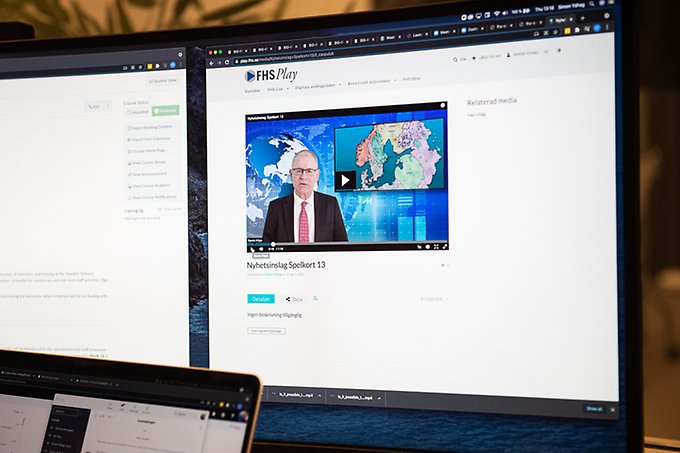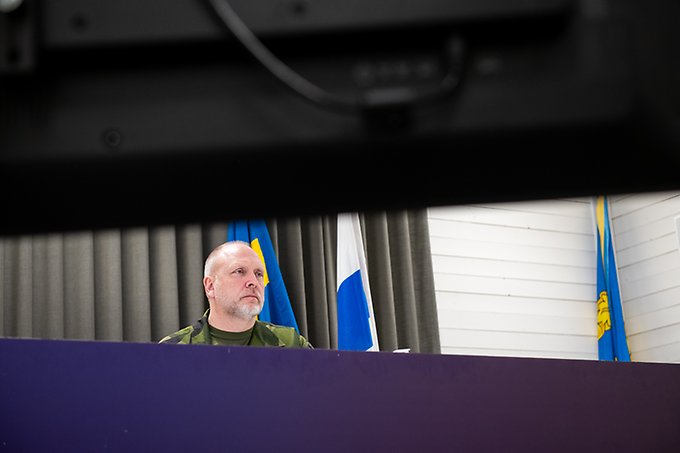
Deputy Vice-Chancellor, Brigadier General Fredrik Ståhlberg participating in the Training Event Joint Operations. Group Nya Älvsborg are joining from home as well as the Finnish Defense University. Group leader Daniel Landin in second frame top row. Photo: Anders G Warne
Finnish-Swedish wargaming replaced traditional exercises
When the coronavirus pandemic put an end to the Combined Joint Staff Exercise (CJSE 2021), Försvarshögskolan, the Swedish Defence University, took a digital approach to the situation. In a short time, the University’s experts developed Training Event Joint Operations: a remote learning exercise that ended with a week of war games with over 500 Finnish and Swedish officers in the same virtual environment.
Twelve faces appear in rows of squares on the screen in the Swedish Defence University’s recording studio. Some wear uniforms and a mouth and nose covering and are situated in a work environment. Others sit at home, without a mouth and nose covering. It is Group 28, Nya Älvsborg, that discusses what proposal for a decision they should present based on the latest playing card in the war games which concludes the remote learning course, Training Event Joint Operations (TEJO).
In the war games, they form a NATO force for the purpose of assisting the government of the fictional country “Southland,” where there is internal strife and part of the country wants to become an independent nation. Neighbouring “Midland” is also suffering from a civil war. And on the playing field there are also two regional major powers, “Euroland” and “Arcticland,” each competing for power and influence over the smaller countries in the region. The scenario comes from the Swedish Armed Forces’ Viking exercise however has been adapted to the war games environment.
The war games is in its fourth and second day of intense play. On the other side of the screen is Brigadier General Fredrik Ståhlberg, Deputy Vice-Chancellor at the Swedish Defence University, while our photographer sneaks around at a coronavirus-appropriate distance. Just outside, parts of the technical war games leadership are watching to make sure that the technology works. Nothing can go wrong. It is also from here that the different playing cards are released to the groups.
“The purpose of the war games is to train decision-making at an operational and higher tactical level. The scenario means that via the various playing cards they are practiced in decision-making and thus from the groups’ presenting concrete proposals, with justifications and rationales, on how they want to use defence branches and combat forces. There is no final result as the object, no right or wrong in the substance, but rather the important thing is for the participants to train their intellect and your capability to make decisions,” Fredrik Ståhlberg informs us.

Carolina Dalmo from Centre for Societal Security and Simon Ydhag from the Anna Lindh Library. Photo: Anders G Warne
From Enköping to Zoom
Those being trained are officers and reserve officers who are studding to be a major or lieutenant colonel at the Finnish National Defence University or Swedish Defence University. For the Swedish reserve officers, this is the final course on a 12-week programme. In their regular life, they are civilians working in business, the government or other organisations. Most are completing their second and final year in the Senior Officers Programme, while a few additional participants commenced their studies last autumn.
“The most useful experience I get out of this is, for me, how to motivate and encourage participation in a temporarily composed group of a variety of nationalities with insufficient information to obtain the requested decision-making basis in the best possible way. Not unlike in a real context,” notes Daniel Landin, who is in his final year of the Senior Officers Programme 19-21 and is the group leader for Nya Älvsborg.
The original plan was that the students would participate in the Swedish Armed Forces’ annual staff exercise Combined Joint Staff Exercise (CJSE) on-site in, for instance, Enköping, Karlskrona or Uppsala. Now everyone is instead in the digital platform Zoom and uses a couple of other digital tools in addition to conduct a different variant of military exercises.
“It actually worked surprisingly well. The comradery and community was there, despite that it was a remote learning exercise. After a year of remote learning, we have a good idea of how we can use the digital platforms. Some playing cards were about developing two different proposals for an issue posed, which is why we in our group made the decision early on to split into two smaller groups each working in their breakout room with the respective proposals. Then we reasoned together, to come to a joint decision. The smaller groups also gave us greater opportunities to get to know each other better,” reports Major Daniel Landin, who studies at the Senior Officers Programme (HOP) 19-21 and was the group leader of Nya Älvsborg during the war games.
On the downside?
“A little too much screen time. It would have been good to have a little physio time in the schedule,” observes Daniel Landin.

Simon Ydhag surveilling the digital war game. Photo: Anders G Warne
Digital terrain
There are in total over 500 persons from the Finnish National Defence University and the Swedish Defence University, who, along with those from the Swedish Armed Forces, use the same digital platform and virtual terrain for a full week. Those who are engaged in the exercise are divided into 36 groups of twelve students each with an experienced officer who is a mentor. Each group has its own digital room, each named after a historical Swedish military battle. The environment also includes a digital restaurant, a dedicated mentoring room, plus an auditorium.
In uncertain pandemic times, we waited a long time in the hope of being able to conduct the CJSE. On 12 January, the Swedish Armed Forces made the decision to cancel and shortly thereafter the Swedish Defence University decided to develop a digital variant it became the Training Event Joint Operations which consisted of three different parts over the same number of weeks.
The overall planning officer was Lieutenant Colonel Magnus Bodén from the Department of Military Studies.
“The Training Event Joint Operations consisted of three parts. Firstly, a purely educational week in classrooms with lectures and seminars. After that, the students had to go into a week’s exercises when they had to translate the theoretical education into skills and finally enter the final week’s war games and be thoroughly tested in decision-making,” reports Magnus Bodén.
A handful of war games and other experts from the Centre for Societal Security (CTSS) were commissioned to develop a scenario-based war game, and with the support of the University’s ICT educators set up technical platforms for hundreds of participants. Everything with a very tight deadline.
“We partially broke new ground, as there was no real basis to start from, but we had a fantastic working relationship within the team with a variety of expertise and with our partner in Finland with Matti Kemppilä in the lead,” reports Per-Åke Mårtensson, Strategic Adviser and Deputy Director for Executive Education at the Centre for Societal Security and responsible for developing the war games during the final week.

Part of the war game consists of pretend and prerecorded news broadcasts. Swedish Defence University teacher Stephen Henly acting news anchor Photo: Anders G Warne
The Deputy Vice-Chancellor is the Exercise Director
The Deputy Vice-Chancellor is ultimately responsible for the exercises, who is known as Exdir, short for Exercise Director, and has both followed along with and participated in the exercises.
“As Exdir, I gave two key guidelines in view of the fact that the CJSE could not be conducted. It was that the TEJO would have an emphasis in the conducting, implementation and decision-making training, and that our colleagues in Finland would participate. Those who have planed the exercises in detail and conducted them have succeeded in this in a particularly meritorious way,” observes Fredrik Ståhlberg.
Training decision-making in large groups
We’re talking about training decision-making in large groups, or crowd-training decision-making. And right now this becomes very significant. The information – the playing cards – are released at intervals in close proximity and the groups have to take a position on complex issues under intense time pressure. A playing card may be a short text, and sometimes it is combined with pre-recorded news items or other videotaped elements. This concerns identifying operational dilemmas, developing alternative plans of action, and establishing the requisite basis on which to reach decisions. The group should be able to deduce how various fighting forces and capabilities should be used for the best operational impact. Each element includes reflection, which is an essential part of pedagogy and learning. Once the group has taken a position it prefers, it presents this to its mentor, who in the role of head receives a presentation for decisions and then provides feedback on the perception of the situation and the decision. For several groups, this afternoon was used for work in groups and then presenting their work to the Deputy Vice-Chancellor who was present. He was very pleased with what he sees and hears.
So too is Lieutenant Colonel Johan Midenby, one of the mentors, who works in the Swedish Armed Forces on a daily basis. He was impressed with the students in everything from digital maturity to collaboration in the group:
“They are field flexible, have a positive attitude, listen to each other and share with each other. Everyone in my group has been active,” he notes, but adds with a wink that it may have to do with the internal rule the group adopted – that anyone who is not active will have to sing a song at tomorrow’s reflection meeting.

Screen shots from the set-up in Zoom. Photo: Simon Ydhag
Finnish-Swedish joint collaboration
Midenby also emphasises the importance of the exchange of experience between the Finnish and Swedish officer students and also the collaboration between the Swedish Armed Forces and the Swedish Defence University.
“I really appreciate that we from the Swedish Armed Forces have the opportunity to contribute and also to meet the students who are our future colleagues. The exercises has also meant learning for me,” says Johan Midenby.
He sees static timeframes as one of the challenges in the structure.
“Greater flexibility would have been good, considering that some playing cards required more work than others.”
Both Johan Midenby and Daniel Landin think that the lack of natural social interaction - “the discussing over a cup of coffee” is what is most lacking when the exercise moves into a digital remote learning environment.
For Daniel Landin and his classmates, the timing was not entirely great either. The exercises were in the middle of the writing of our degree essay.
Pandemic-proof version of the CJSE
The Training Event Joint Operations is conducted as part of the Senior Officers Programme at the Swedish Defence University as a replacement for the Swedish Armed Forces staff exercise, the Combined Joint Staff Exercise (CJSE), which ordinarily is offered every two years but has been cancelled due to the coronavirus pandemic.
It’s a whole lot different when the well-known CJSE is adapted for the pandemic, but a few things are recognisable. The basic scenario comes from the Swedish Armed Forces’ Viking exercises and is something many of the participants will recognise. Even with the digital version, the excellent joint cooperation between Finland and Sweden continues. Students from the Finnish staff training course are included in the training and their teachers at the Finnish National Defence University, and their teachers have participated as instructors and mentors.
“I regard this as extremely positive that we are able to work together with our Finnish counterparts once again. This provides additional dimensions and an important exchange of experience,” notes Brigadier General Fredrik Ståhlberg.
The pilot project
“This is a large-scale pilot project, which we developed within a brief planning horizon. A risk analysis has been continuously conducted and the primary risks that were identified were information security-related and system-related. When 500 people are online in the same structure at the same time, the technical systems are vulnerable, but actually it worked out very well,” reports Per-Åke Mårtensson.

Deputy Vice-Chancellor Fredrik Ståhlberg. Photo: Anders G Warne
Page information
- Published:
- 2021-05-11
- Last updated:
- 2021-05-11
